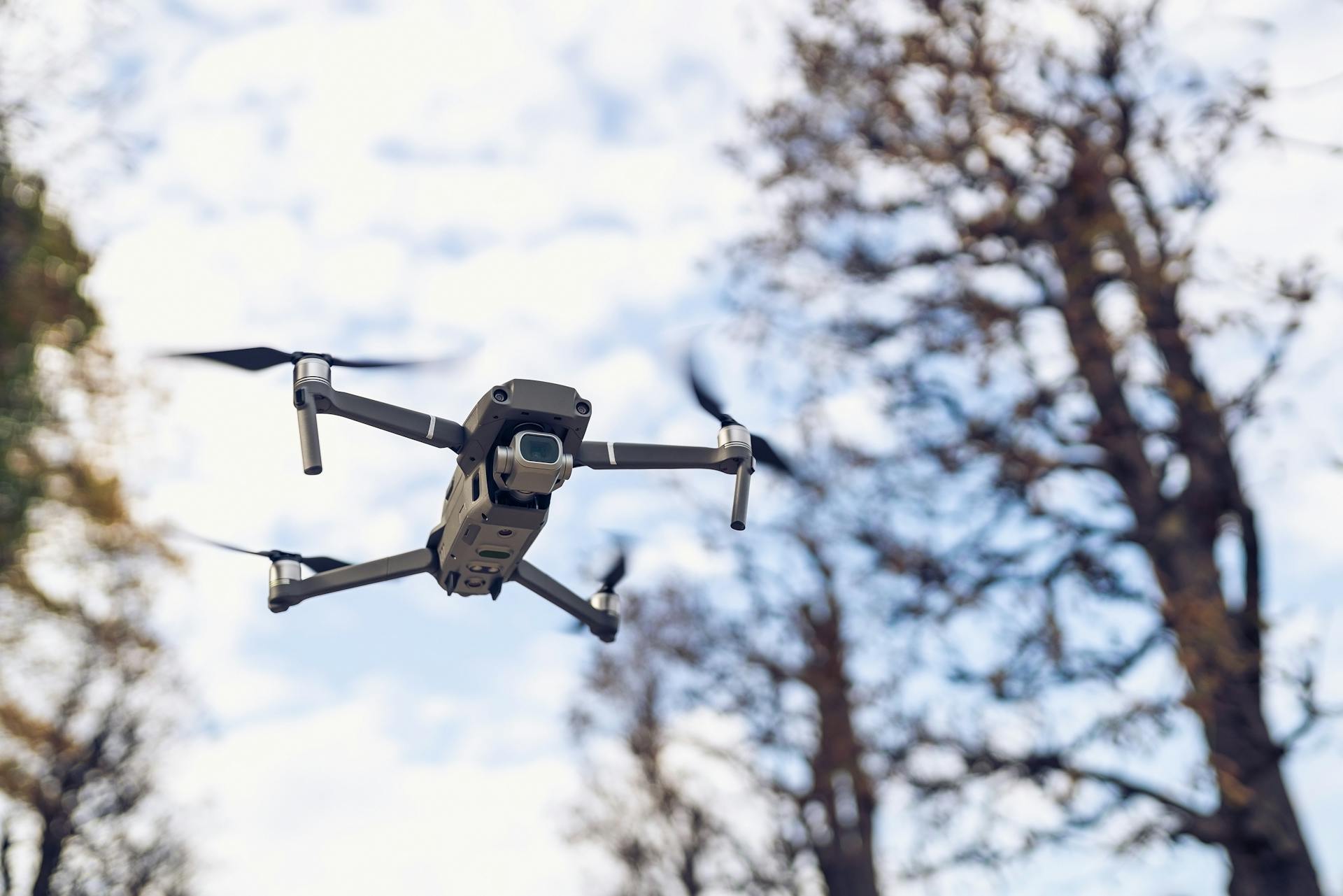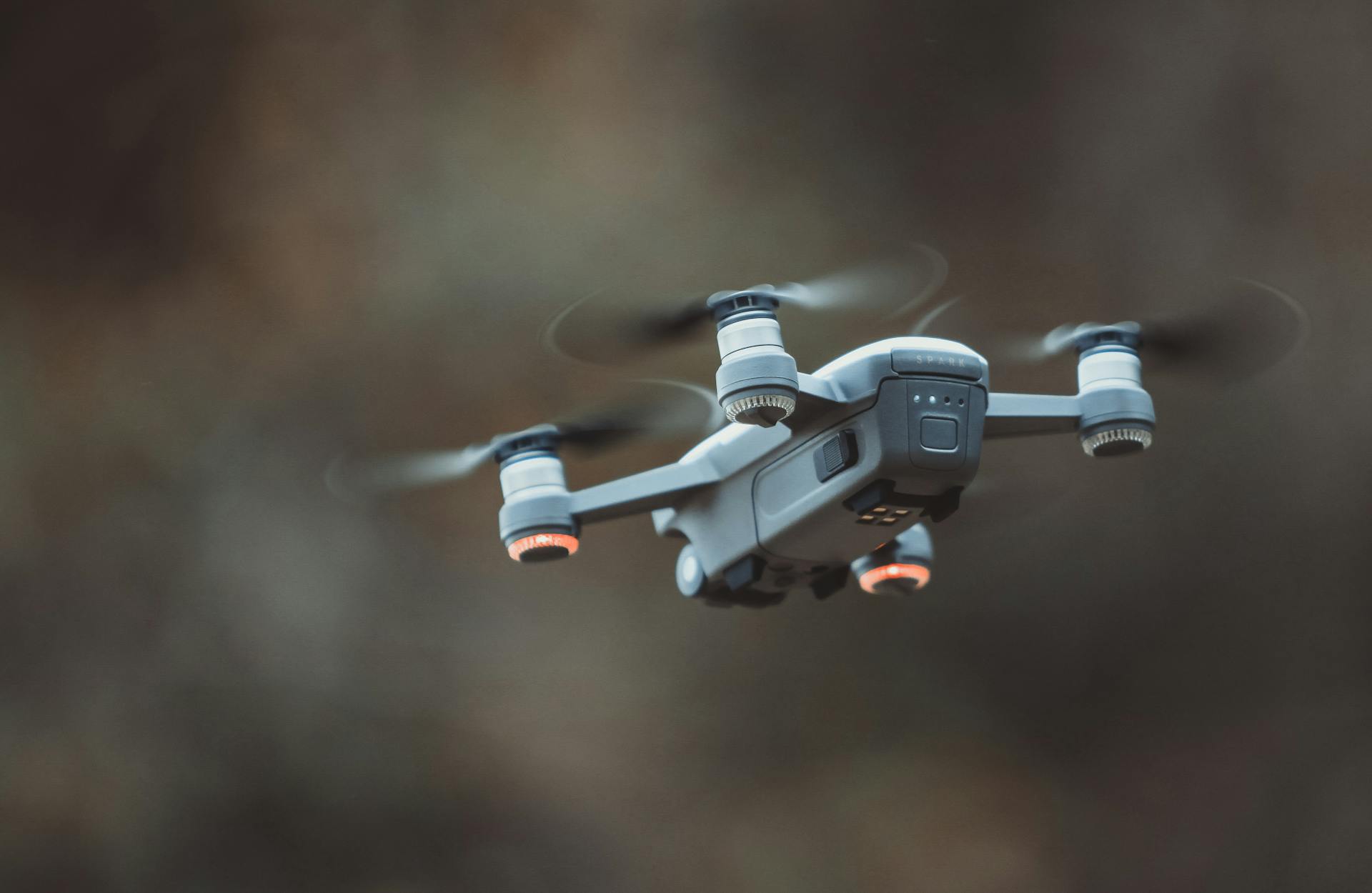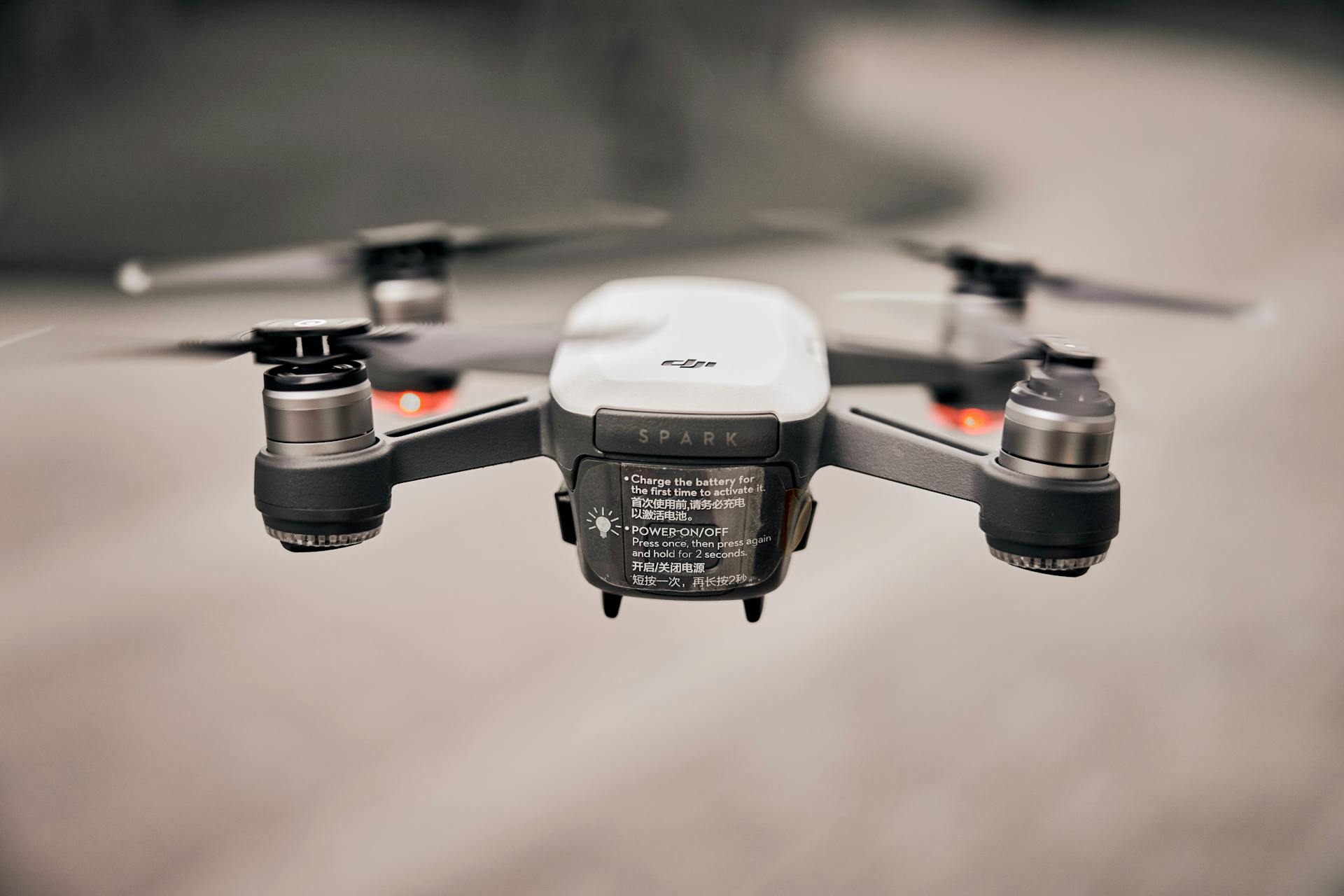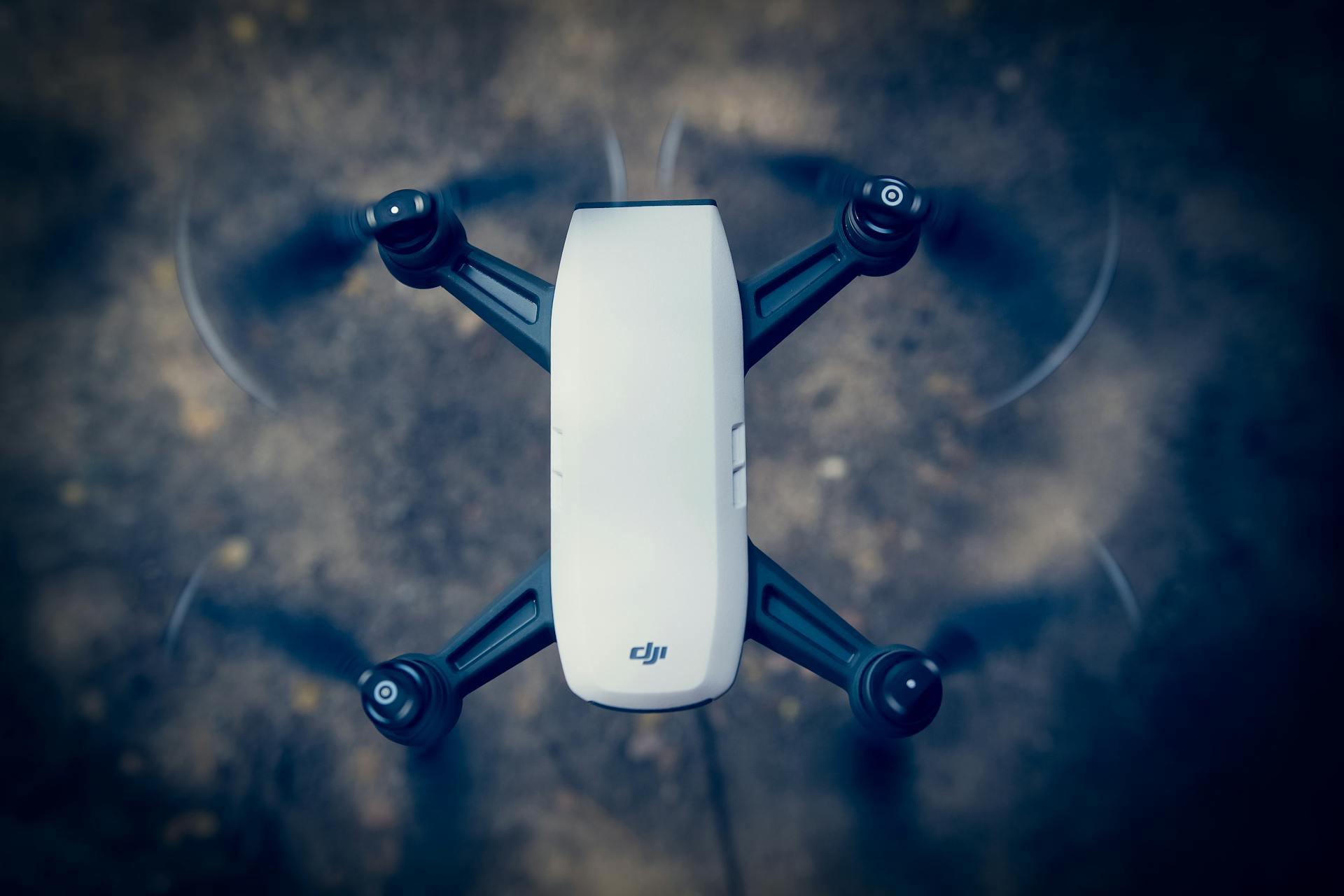
A quadrotor is a type of unmanned aerial vehicle (UAV) that uses four rotors to generate lift and propulsion.
Quadrotors are also known as quadcopters, and they typically have a compact design with a square or rectangular shape.
The key to a quadrotor's stability is its ability to tilt the rotors, which is made possible by the use of brushless motors and electronic speed controllers.
Each rotor has its own motor, allowing for precise control over the aircraft's movement in all directions.
By adjusting the speed of the rotors, a quadrotor can achieve a stable hover or move in any direction, making it a versatile tool for a variety of applications.
Design and Structure
Quadrotors are designed with a focus on simplicity and efficiency, which is reflected in their mechanical structure. The main components include a fuselage or frame, four rotors, and motors, with the motors and propellers typically being equidistant for best performance.
The design of quadrotors allows for a significant reduction in size and weight compared to crewed aircraft, making them ideal for small civilian use. They can be built with lighter materials and use less robust electronic control systems.
The quadcopter design has become popular for small UAVs due to its stability and maneuverability. This layout is rarely used for crewed aircraft, however.
For remote human control, quadrotors rely on a camera and video link to replace the cockpit windows, and radio-transmitted digital commands to replace physical cockpit controls. This allows for more efficient and streamlined operation.
Explore further: Unmanned Aerial Drones
Flight Principles
Quadcopters rely on Newton's Third Law of Motion to ascend and navigate through the air, with the action of spinning propellers pushing air downwards resulting in an upward force, or lift.
The lift force must surpass the force of gravity for the quadcopter to rise, and achieving a hover state involves balancing lift with gravitational pull.
Here's an interesting read: Micro Air Vehicles
Quadcopters can move laterally by changing the speed of their propellers, with an uneven distribution of lift causing the quadcopter to move towards the side generating less lift.
Increasing the speed of two propellers on one side and decreasing the speed of the two propellers on the opposite side leads to lateral movement, whether left, right, forward, or backward.
By leveraging torque, quadcopters can also facilitate rotational movement, with altering the speeds of the propellers causing a torque imbalance that results in rotation.
Increasing the speed of propellers on one diagonal axis and decreasing the speed on the opposite diagonal causes the quadcopter to rotate towards the slower side.
Flight Principles
Lift is created when a quadcopter's propellers spin, pushing air downwards and generating an upward force according to Newton's Third Law of Motion.
This principle is fundamental to flight, enabling quadcopters to ascend and navigate through the air. The action of the propellers pushing air downwards results in an equal and opposite reaction, which is the lift that allows the quadcopter to rise.
Quadcopters have two rotors spinning clockwise and two counterclockwise, which cancels out opposing torques and stabilizes the vehicle.
To achieve a hover state, the lift force must be balanced with gravitational pull, maintaining a steady altitude without vertical movement. This balance is crucial for stable flight.
The speed of the propellers is also used to control lateral movement, as increasing the speed of two propellers on one side and decreasing the speed on the other side leads to an uneven distribution of lift, causing the quadcopter to move towards the side generating less lift.
Torque plays a significant role in flight, as each spinning propeller generates a torque that tends to rotate the quadcopter's body in the opposite direction. This effect is countered by designing two propellers to spin clockwise and the other two counter-clockwise.
Rotational movement is also facilitated by torque, with differential propeller speeds allowing the quadcopter to execute precise rotational maneuvers. To initiate a counterclockwise rotation, the speed of the propellers on one diagonal axis is increased, while the speed on the opposite diagonal is decreased.
Loop Principles
UAVs employ different control architectures, but at their core, they rely on loop principles to navigate and adjust their behavior.
Open-loop control is a type that provides a positive control signal without incorporating feedback from sensor data. This means the UAV will follow the signal without adjusting its behavior based on what it's sensing.
In contrast, closed-loop control incorporates sensor feedback to adjust behavior. This is a more advanced approach that allows the UAV to make adjustments on the fly, such as reducing speed to reflect a tailwind.
The PID controller is a common tool used in closed-loop control, allowing the UAV to make precise adjustments to its behavior.
A fresh viewpoint: Long Endurance Uav
Vortex Ring State
The vortex ring state is a phenomenon that can occur in all quadcopters, including the one I helped my friend test fly last weekend.
It's caused by normal rotorcraft aerodynamics, which is a fancy way of saying it's a natural part of how quadcopters interact with the air.
In simple terms, it happens when a quadcopter creates a vortex ring by sucking air in through its rotors and then expelling it downwards.
This vortex ring can cause a quadcopter to lose lift and start descending, which can be a problem if you're not expecting it.
So, it's essential to be aware of the vortex ring state and take steps to prevent it from happening, such as avoiding hovering in tight spaces or making sharp turns.
Quadrotor Components
A quadrotor's components are what make it fly, and they're pretty cool. The frame, which is made of materials like wood, plastic, or carbon fiber, holds everything together.
Frames come in different sizes, measured in millimeters, and 250 millimeters is a common size for racing quadcopters. You'll want to choose a frame that has enough space for your ESC, flight controller, and any other accessories you want to add.
The flight controller is the brain of your quadrotor, controlling the speed of your motors and accepting signals from your radio receiver. It's essentially a small computer that can be programmed and updated.
Aircraft Configuration
A quadcopter's aircraft configuration plays a significant role in its overall performance and design.
The flying wing and blended wing body configurations are popular for conventional flight due to their light weight and low drag, making them suitable for many use cases.
For larger quadcopters that carry a variable payload, a distinct fuselage with a tail is often used for stability, control, and trim.
The tailless quadcopter design is common for smaller quadcopters that require vertical flight or hovering, as it requires a relatively simple control system.
Multirotor designs with 6 or more rotors are more common in larger quadcopters, where redundancy is prioritized for added safety and reliability.
Frames can be made of various materials, including wood, plastic, or carbon fiber, with carbon fiber being strong but also brittle.
The frame size of a quadcopter is specified in millimeters, with common sizes being 180, 250, and 400 millimeters, and racing quadcopters often using the 250 millimeter variety.
Worth a look: Remote Control Military Drone
Motors
Quadcopter motors are a crucial component, and selecting the right ones can be a bit confusing.
Most quadcopters use brushless DC motors, which consist of a rotor with a permanent magnet and a number of electromagnets surrounding it.
The number of poles in a brushless motor can range from 2 to 14, and the more poles it has, the more precisely it can be controlled.
A key specification of a quadcopter motor is its KV rating, which is a rating of the number of revolutions per minute (RPM) that the motor will turn when a 1-volt potential difference is applied to the motor with no load.
Typical KV ratings for quadcopters are between 500 and 2500, with lower KV motors able to swing big propellers and create more thrust.
A general rule of thumb is that quadcopters that weigh more than 1 kilogram will use a motor in the range of 700 to 900 KV.
You might like: Quadrotor Motor
The maximum current rating of the motor is another important factor, measured in amperes, which you'll need to know before choosing your electronic speed controller (ESC) and battery.
The thrust rating of a motor is specified in conjunction with a propeller size, and it's essential to know the total weight of your quadcopter, including the weight of the motors themselves.
A basic rule of thumb is that the motor and propeller combination should be able to generate twice the weight of the craft in thrust.
The diameter of the shaft is also important, as it determines what propellers you will be able to match with the motor.
You'll also want to look at the mounting screw pattern and motor mounts to ensure that your motor can be successfully mounted to the frame of your quadcopter.
Electronic Speed Controllers
Electronic Speed Controllers are a crucial component of your quadrotor, and for good reason. They control the Brushless DC motors, which are essential for flight.
You'll need one ESC for each motor, and these devices have three sets of wires. Two of these sets are heavy-gauge wires that connect to the power distribution board, which supplies voltage to the ESC and motors.
The third set of heavy-gauge wires connects to your brushless motor, while three smaller wires connect to your flight controller.
Make sure to choose an ESC that's rated higher than the motor's maximum current, as this will ensure safe and reliable operation.
Torque
Torque is a crucial component in quadrotor flight, and it's essential to understand how it works.
When all four rotors are spinning at the same angular velocity, the net torque about the yaw axis is zero, eliminating the need for a tail rotor.
A quadrotor adjusts its yaw by applying more thrust to rotors rotating in one direction, creating a torque imbalance that causes the aircraft to rotate.
To induce yaw, you need to offset the cumulative thrust commands between the counter-rotating blade pairs.
This can be achieved by increasing the speed of one set of propellers while decreasing the speed of the other set, creating a torque imbalance that causes the quadrotor to rotate.
For example, to initiate a counterclockwise rotation, the speed of the propellers on one diagonal axis is increased, while the speed on the opposite diagonal is decreased.
By matching the motor to the propeller, you can also achieve stability, which is especially important when carrying a camera.
A quadrotor adjusts its pitch or roll by applying more thrust to one rotor (or two adjacent rotors) and less thrust to the diametrically opposite rotor.
Power Sources
Power Sources play a crucial role in determining the flight duration, range, and environmental impact of a quadrotor. There are several types of power sources available, each with its own set of advantages and limitations.
Battery-powered quadrotors use rechargeable batteries, offering quiet operation and lower maintenance, but potentially limited flight times. This makes them suitable for urban environments and sensitive operations.
Fuel-powered quadrotors, on the other hand, utilize traditional fuels like gasoline or diesel, which often results in longer flight times but may be noisier and require more maintenance.
Hybrid quadrotors combine electric and fuel power sources, aiming to balance the benefits of both systems for improved performance and efficiency. This configuration could allow for versatility in mission profiles and adaptability to different operational requirements.
Solar-powered quadrotors can potentially achieve extended flight times by harnessing solar energy, especially at high altitudes. This makes them particularly suited for long-endurance missions and environmental monitoring applications.
Here's a brief overview of the different power sources available:
Radio Equipment
Radio equipment is a crucial part of your quadcopter setup. You'll need a transmitter and receiver to control your device.
A transmitter controls the quadcopter, while a receiver receives the signals. Both the transmitter and receiver are specified by the number of channels they support and the frequency they operate on. Typically, you'll need at least four channels to control a basic quadcopter.
Each channel controls a single function or device in the quadcopter. The four basic channels are used for throttle, yaw, pitch, and roll. You can also use extra channels to control lighting or a gimbal motor to position a camera.
Most people start with at least six channels. This allows for more advanced control and customization. If you plan to use several quadcopters, you can buy one transmitter and several compatible receivers.
The mode of your transmitter-receiver combination determines the control configuration on the transmitter. There are two main modes: mode 1 and mode 2. Mode 2 is the most popular configuration, with the elevator control on the right joystick and the throttle control on the left joystick.
Computer Control Systems
The computer control system is the heart of a quadrotor's autonomous flight capabilities. It's what allows your drone to think and act on its own, without constant human input.
The quadcopter configuration is relatively simple to program for autonomous flight, making it a great platform for experimenting with complex swarming behavior based on basic sensing of the adjacent drones.
The computing capability of UAVs has evolved significantly over the years, starting with analog controls and progressing to microcontrollers, system-on-a-chip, and single-board computers. This evolution has led to the development of sophisticated flight control systems.
Modern system hardware for UAV control is often called the flight controller (FC), flight controller board (FCB), or autopilot. This module typically incorporates a primary microprocessor, a secondary or failsafe processor, and sensors such as accelerometers, gyroscopes, magnetometers, and barometers.
In 2024, EASA agreed on the first certification basis for a UAV flight controller in compliance with the ETSO-C198 for Embention's autopilot. This certification aims to facilitate the integration of UAVs within the airspace and the operation of drones in critical areas.
The flight controller is the brains of your quadcopter, responsible for controlling the speed of your motors by sending signals to your ESCs.
For more insights, see: High Altitude Long Endurance Uav
Quadrotor Types and Uses
Quadrotors come in various types, each with its own unique characteristics and uses. These types include the X Quadcopter, H Quadcopter, + Quadcopter, Y4 Quadcopter, and V-tail or A-Tail Quadcopter.
The X Quadcopter is a versatile design used for aerial photography, videography, racing, and acrobatic stunts. Its frame variations include true X, square, hybrid X, and stretched X.
The H Quadcopter features an H-shaped frame and is known for its stability. This makes it a great option for those who want a reliable and easy-to-fly quadrotor.
The + Quadcopter excels in straight flight paths with aerodynamically efficient propeller positions. This is often used in acrobatic flying, where speed and agility are key.
The Y4 Quadcopter is similar to a tricopter but with two motors mounted coaxially on the rear arm. This provides better yaw control and lifting power.
The V-tail or A-Tail Quadcopter offers enhanced yaw control through rear motors mounted at an angle. This utilizes thrust for turning, making it a great option for those who want more control over their quadrotor.
Quadrotors are used in a variety of sectors, from personal hobbies to critical commercial applications. They are a versatile tool that can be used for a range of tasks, including aerial photography and videography.
Some of the reasons why quadcopters are the most popular type of drone include their small size, mechanical simplicity, and affordability. They are also relatively cheap and lightweight, making them less susceptible to stringent drone laws.
Here are some of the most common types of quadcopters and their uses:
For personal use, quadrotors are popular for aerial photography and videography. They are also frequently used by hobbyists and enthusiasts for racing and recreational flying due to their ease of control and agility.
Quadrotor Performance
A quadrotor's performance is impressive, with some models capable of carrying payloads of up to 1.5 kilograms.
Their agility is due in part to their ability to rotate at a rate of up to 90 degrees per second.
They can also reach speeds of up to 50 kilometers per hour, making them suitable for a variety of applications.
Their stability is ensured by a system of gyroscopes and accelerometers that work together to maintain equilibrium.
Their ability to hover in place is a result of the difference in speed between the four rotors.
Quadrotor Applications
Quadrotors have become a versatile tool across multiple sectors, ranging from personal hobbies to critical commercial applications.
They're used for surveying and mapping land, monitoring wildlife, and even photographing properties in real estate. This is a cost-effective and efficient means of aerial surveillance and data collection.
Quadrotors play a critical role in infrastructure inspection and maintenance in industrial settings. They inspect hard-to-reach areas of buildings, bridges, and power lines, providing a safe and economical alternative to manual inspections.
Drones are ideally suited to capturing aerial shots in photography and cinematography. They provide access to dangerous, remote or otherwise inaccessible sites.
Commercially, quadrotors are used for advertising, carrying banners or display lights for promotional purposes. This niche application has found a lot of use in various industries.
Broaden your view: Puma Unmanned Aerial Systems
Quadrotor Technology
Quadrotor technology is based on the concept of four rotors, which provide stability and control to the aircraft.
These four rotors are typically arranged in a square or X configuration, allowing for smooth and stable flight.
Each rotor is connected to a motor, which is powered by an electrical source, such as a battery or a fuel cell.
The quadrotor's ability to lift off the ground and hover in place is due to the difference in air pressure between the rotors and the surrounding air.
A quadrotor can achieve vertical takeoff and landing (VTOL) capabilities, making it a versatile and practical aircraft.
Quadrotor technology has been applied in various fields, including surveillance, search and rescue, and aerial photography.
The quadrotor's stability and maneuverability make it an ideal platform for capturing high-quality images and video footage.
Quadrotors can fly at speeds of up to 50 km/h and can reach altitudes of up to 100 meters.
Frequently Asked Questions
What is the difference between a drone and a quadcopter?
While the terms "drone" and "quadcopter" are often used interchangeably, a drone can refer to any unmanned aerial vehicle, whereas a quadcopter specifically describes a type of drone with four rotors. Understanding the difference between these terms is key to grasping the broader world of drones.
Featured Images: pexels.com


